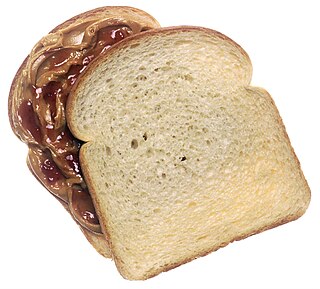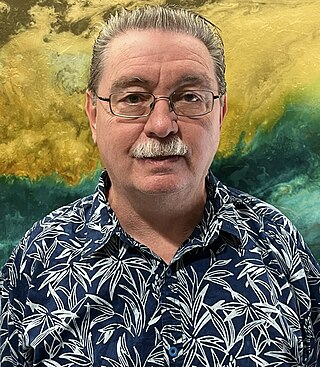Rheology is the study of the flow of matter, primarily in a fluid state, but also as "soft solids" or solids under conditions in which they respond with plastic flow rather than deforming elastically in response to an applied force. Rheology is a branch of physics, and it is the science that deals with the deformation and flow of materials, both solids and liquids.
Pierre J. Carreau is a rheologist, the author of the model of Carreau fluid. He is a professor emeritus at École Polytechnique in Montreal and the founding director of CREPEC.

A rheometer is a laboratory device used to measure the way in which a viscous fluid flows in response to applied forces. It is used for those fluids which cannot be defined by a single value of viscosity and therefore require more parameters to be set and measured than is the case for a viscometer. It measures the rheology of the fluid.
Curing is a chemical process employed in polymer chemistry and process engineering that produces the toughening or hardening of a polymer material by cross-linking of polymer chains. Even if it is strongly associated with the production of thermosetting polymers, the term "curing" can be used for all the processes where a solid product is obtained from a liquid solution, such as with PVC plastisols.

Food rheology is the study of the rheological properties of food, that is, the consistency and flow of food under tightly specified conditions. The consistency, degree of fluidity, and other mechanical properties are important in understanding how long food can be stored, how stable it will remain, and in determining food texture. The acceptability of food products to the consumer is often determined by food texture, such as how spreadable and creamy a food product is. Food rheology is important in quality control during food manufacture and processing. Food rheology terms have been noted since ancient times. In ancient Egypt, bakers judged the consistency of dough by rolling it in their hands.
Rheological weldability (RW) of thermoplastics considers the materials flow characteristics in determining the weldability of the given material. The process of welding thermal plastics requires three general steps, first is surface preparation. The second step is the application of heat and pressure to create intimate contact between the components being joined and initiate inter-molecular diffusion across the joint and the third step is cooling. RW can be used to determine the effectiveness of the second step of the process for given materials.

Melt blowing is a conventional fabrication method of micro- and nanofibers where a polymer melt is extruded through small nozzles surrounded by high speed blowing gas. The randomly deposited fibers form a nonwoven sheet product applicable for filtration, sorbents, apparels and drug delivery systems. The substantial benefits of melt blowing are simplicity, high specific productivity and solvent-free operation. Choosing an appropriate combination of polymers with optimized rheological and surface properties, scientists have been able to produce melt-blown fibers with an average diameter as small as 36 nm.

Matthew V. Tirrell is an American chemical engineer. In 2011 he became the founding Pritzker Director and dean of the Institute for Molecular Engineering (IME) at the University of Chicago, in addition to serving as senior scientist at Argonne National Laboratory. Tirrell's research specializes in the manipulation and measurement of polymer surface properties, polyelectrolyte complexation, and biomedical nanoparticles.
Ashish Kishore Lele is an Indian chemical engineer, rheologist and the Director of the National Chemical Laboratory, Pune. He is known for his researches on micro and mesostructure of polymers and is an elected fellow of the Indian Academy of Sciences, and the Indian National Academy of Engineering. The Council of Scientific and Industrial Research, the apex agency of the Government of India for scientific research, awarded him the Shanti Swarup Bhatnagar Prize for Science and Technology, one of the highest Indian science awards for his contributions to Engineering Sciences in 2006. He received the Infosys Prize in 2012.

Yogesh Moreshwar Joshi is an Indian chemical engineer, rheologist and the Pandit Girish & Sushma Rani Pathak Chair Professor at the Indian Institute of Technology, Kanpur. He is known for his studies on metastable soft matter and is an elected fellow of the Society of Rheology, Indian National Science Academy, Indian Academy of Sciences, and Indian National Academy of Engineering. In 2015, the Council of Scientific and Industrial Research, the apex agency of the Government of India for scientific research, awarded Joshi the Shanti Swarup Bhatnagar Prize for Science and Technology for his contributions to Engineering Sciences. In 2023, he received prestigious J C Bose fellowship constituted by the Science and Engineering Research Board, Government of India.
Frank Steven Bates is an American chemical engineer and materials scientist. Bates is a Regent's Professor (2007–present), a Distinguished McKnight University Professor (1996–present), and department head (1999-2014) in the department of chemical engineering and materials science at the University of Minnesota, where he has been a faculty member since 1989. Prior to his appointment at the University of Minnesota, Bates was a member of the technical staff at AT&T Bell Laboratories from 1982-1989.
Horst Henning Winter is a German American chemical engineer, educator and researcher. He is a distinguished professor at the University of Massachusetts Amherst, and was the executive editor of Rheologica Acta from 1989 to 2016, where he has served as honorary editor since 2017.
Interfacial rheology is a branch of rheology that studies the flow of matter at the interface between a gas and a liquid or at the interface between two immiscible liquids. The measurement is done while having surfactants, nanoparticles or other surface active compounds present at the interface. Unlike in bulk rheology, the deformation of the bulk phase is not of interest in interfacial rheology and its effect is aimed to be minimized. Instead, the flow of the surface active compounds is of interest..

Julia A. Kornfield is a Professor of Chemical Engineering at the California Institute of Technology. A world expert in polymer science, Kornfield's research encompasses the development of mega-supramolecular systems for fuel additives and intraocular lenses, as well as the influence of flow on polymer chains.
Ronald G. Larson is George G. Brown Professor of Chemical Engineering and Alfred H. White Distinguished University Professor at the University of Michigan, where he holds joint appointments in macromolecular science and engineering, biomedical engineering, and mechanical engineering. He is internationally recognized for his research contributions to the fields of polymer physics and complex fluid rheology, especially in the development of theory and computational simulations. Notably, Larson and collaborators discovered new types of viscoelastic instabilities for polymer molecules and developed predictive theories for their flow behavior. He has written numerous scientific papers and two books on these subjects, including a 1998 textbook, “The Structure and Rheology of Complex Fluids”.
Olagoke Olabisi is an author, editor, educator, mentor, inventor, and entrepreneur. A Nigerian–American chemical engineer, Olagoke is the Chief Consultant and CEO of Infra-Tech consulting LLC, an energy consulting company focused on corrosion and materials engineering. He has 9 patents and a total of 97 publications including Fugacity and Vapor Pressure of Non-Polar Liquids at Low Temperatures, Thermoplastics Beyond the Year 2000: A Paradigm, and Handbook of Thermoplastics, 2nd Edition. He has been involved in academia and industry in the United States, Nigeria, Saudi Arabia, and Kuwait. He is a mentor to students and young professionals.

Rachel (Raya) Takserman-Krozer was a theoretical physicist and professor of rheology. Takserman-Krozer worked on diverse aspects of theoretical physics ranging from theory of relativity to studies of polymers and their flow. Her scientific work includes contributions to behaviour of polymers and polymers solutions in velocity fields, theory of spinnability, problems of phenomenological rheology, and molecular-statistical theory of polymer networks. Takserman-Krozer worked across several countries including Russia, Poland, Israel, and Germany.
Andy Haishung Tsou is a retired ExxonMobil materials scientist known for developing synchrotron X-ray scattering and atomic force microscopy techniques for polymer research, applying the techniques in service of development and commercialization of new polyolefin materials.

Jimmy W. Mays is an American polymer scientist, academic, and author. He is a Professor Emeritus at the University of Tennessee.
David John Lohse is a retired ExxonMobil materials scientist known for contributions on thermodynamics of mixing, nanocomposites for controlling permeability, neutron scattering of polymers, rheology of polymers.







